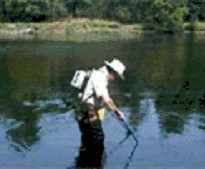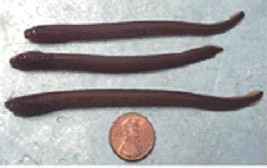Lake Champlain Fish and Wildlife Resources Office
Lamprey Assessment  Each summer in the Lake Champlain Basin, the U.S. Fish and Wildlife Service conducts stream and river surveys for larval sea lamprey. After hatching, these larvae spend four years in their natal stream, buried beneath the sediment as filter-feeders before reaching their infamous parasitic phase. Surveys for larval sea lamprey are done in streams and rivers and are designed to both locate populations and where present, estimate their densities. To roust the larvae from their burrows specialized electrical equipment is used to deliver current through the water that initially provokes the larvae to swimming then temporarily stuns them to enable collection. After locating lamprey-colonized streams, scientific sampling strategies are used to produce population estimates for each stream. These population assessment data are ultimately what is used to justify physical (trapping and barriers) and chemical lamprey control efforts in the Lake Champlain Basin. UPDATE 2007!!! Status of Sea Lamprey Control in the Poultney River -2007 Lampricide treatment of the Poultney River was deferred for five years after initiation of the long-term Lake Champlain sea lamprey control program. The rationale for this strategy is detailed in the program’s 2001 Final Supplemental EIS. A brief summary is presented below: The Poultney River was designated an “outstanding resource water” in 1991 by the Vermont Water Resources Board in response to a petition from local activists who cited the river’s exceptional natural, cultural, scenic and recreational values. Proposed activities affecting outstanding resource waters are held to a higher regulatory standard than for similar proposals on other rivers. In an administrative guidance document, VTDEC stated that “Increased scrutiny and caution in the issuance of an aquatic nuisance control permit for an outstanding resource water should be expected.” The high biodiversity of aquatic species, particularly mussels, was a significant factor in the designation. Advocates often state that the Poultney River has the most diverse mussel community in New England, with 12 mussel species, including seven state endangered and threatened (E&T) species. The Poultney is not especially unique in this regard, however. For comparison, the Missisquoi River is also known to have 12 mussel species, including seven E&T species; and 11 species are known to occur in both Otter Creek and Lewis Creek (each with five E&T species). Results of numerous toxicity studies and treatment observations demonstrate that we can effectively apply lampricides with little or no impact on mussel populations. The outstanding resource water designation, along with opposition to lampricide use by a vocal minority resulted in a compromise strategy that deferred treatment for five years, allowing time to assess potential alternatives to lampricides and to see if target wounding rates could be achieved without treating the Poultney River. Treatment would be proposed in five years if no feasible alternative control methods are available and if wounding rate targets are not met. Long-term sea lamprey control began in 2002, which brings the five-year period to a close in 2007. Through this period, the Lake Champlain Fish and Wildlife Management Cooperative convened a sea lamprey control alternatives working group to explore potential non-lampricide control methods. The working group, comprised of agency staff, university professors and stakeholders representing various angling and environmental organizations, collaborated to sponsor several research projects to evaluate or develop potential alternatives. No feasible alternatives to lampricides in the Poultney River have been identified to date. Wounding rates on lake trout, landlocked salmon and walleye continue to exceed program objectives. For example, observed rates for 21 to 25 inch lake trout have ranged from 62 to 94 wounds per 100 fish since 2002, far above the target of 25. If the spring 2007 walleye assessment shows a wounding rate above the walleye target, then treatment of the Poultney will be proposed for fall 2007. If the 2007 walleye wounding target is met, but lake trout and/or salmon targets are not met during the fall 2007 salmonid assessment, then treatment will be proposed for fall 2008. With a 2006 population estimate of over 171,000 sea lamprey larvae in the Poultney River system, treatment is critical to the success of the lamprey control program. Prepared by: Brian Chipman, Vermont Fish and Wildlife Department December 18, 2006 |